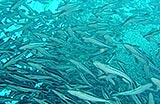Conservation research: The cost of rebuilding fisheries
by Laurel Zaima, RJD intern
The depletion of fish stocks is a direct result from human’s impact on the ocean. Overexploitation, pollution, and habitat loss are the driving forces behind this problem. Data indicates that the overall rate of fishing is inclining, the condition of global fisheries is declining, and the socio-economic benefit of fishing is being compromised. The fisheries are receiving extra pressure to increase their catch despite the fisheries and management policies that are being applied by coastal States. The 2002 World Summit on Sustainable Development (WSSD) tried to create a solution for this problem. The WSSD has set a target for fisheries in order to maintain and restore the stocks to a maximum sustainable yield (MSY) by 2015.
A bio-economic model was created with the intentions estimating the ultimate benefits for both the economy and the biodiversity of the ocean. The results indicate that the global fishing capacity needs to be cut by 36-46% from 2008 level. The negative effects of this cut included the loss of employment for 12-15 million fishers and costing the United States $96-358 billion for buy backs. On the other hand, the positive effects includes an increase in the annual fishery production $ 16.5 million tones, annual rent by US $32 billion and improvement of the biodiversity of the marine ecosystem. Unfortunately, the rebuilding of stocks has been delayed because many people are unwilling to accept the short-term socio-economic consequences that occur in order to restore the fish stocks.
The overall goal of The WSSD is to restore the overexploited fish populations and to set an optimal fishing level by 2015. The data shows that the overfishing problem is increasing and the trend is continuously distancing itself from the safe biological limits. This demonstrates that progress towards stock restoration is not being made by world marine fisheries, and the WSSD goal is probably not going to be achieved by 2015. Therefore, the deadline for this goal has been relaxed so that a more realistic result can be attained. Instead of focusing on immediately reaching the maximum sustainable yield, the WSSD decided to simply start concentrating on the actions that need to be carried out to start the restoration process. The first step is to start eliminating the fishing pressure on the stocks from the world fishing fleets. Stricter limitation regulations need to be enforced, ensuring that the fishing is controlled at the MSY level.
Sustainable fishing practices are extremely beneficial to the fishing industry, economy, and the fish biodiversity. If the stocks are restored to the MSY level, the world’s fisheries can increase production by the difference between the MSY and the current production: about 16.5 million tons. In addition, if the fleet size were to reduce, the increased production and revenue could bring fishing industry at an estimated total of $32 billion per year at 2004 prices. The replenishment of the overexploited fish stocks can also aid the ecological and social benefits, such as, tourism, snorkeling, and scuba diving. Overall, the three main benefits include: enrich biodiversity, resilience of the marine ecosystems, and increasing the productivity of the fishing industry. These important and valuable benefits far out weighing the short term sacrifices that result from reaching this goal.
Ye, Y., Cochrane, K., Bianchi, G., Willmann, R., Majkowski, J., Tandstad, M., & Carocci, F. (2012). Rebuilding global fisheries: the World Summit Goal, costs and benefits Fish and Fisheries DOI: 10.1111/j.1467-2979.2012.00460.x




“We are in the situation where 40 years down the line we, effectively, are out of fish.” —Pavan Sukhdev, UN Environment Programme
I just saw the movie “End of The Line”.
I thought it provided a good documentation on how pervasive across the earth over fishing is.
And more importantly how countries and corporations are doing everything they can to circumvent imposed fishing restrictions.
“One in five people on this planet depends on fish as the primary source of protein.” —Food and Agriculture Organization
Because of the importance of a nation’s ability to feed it’s people, the loss of a food source becomes (as with all things economic) political.
As each fishery collapses, the European and Asian countries will move onto the next one in order to provide food.
And that only becomes exacerbated by population growth.
“During the 20th century alone, the population in the world has grown from 1.65 billion to 6 billion.”
How will the WSSD enforce their time timetable, without every industrialized country with a modern fishing fleet being on board?